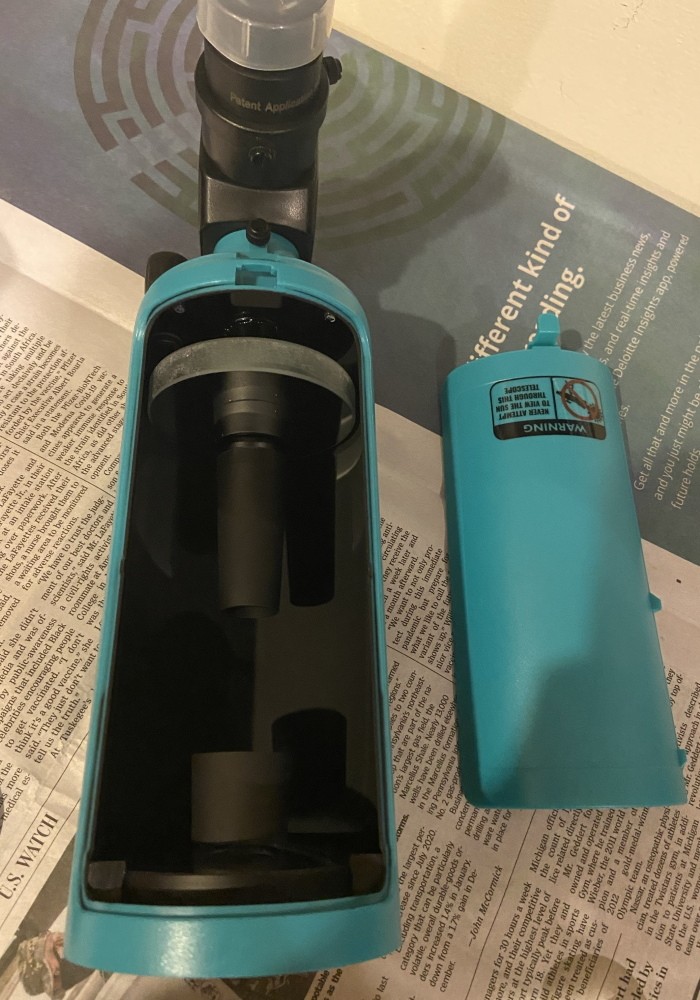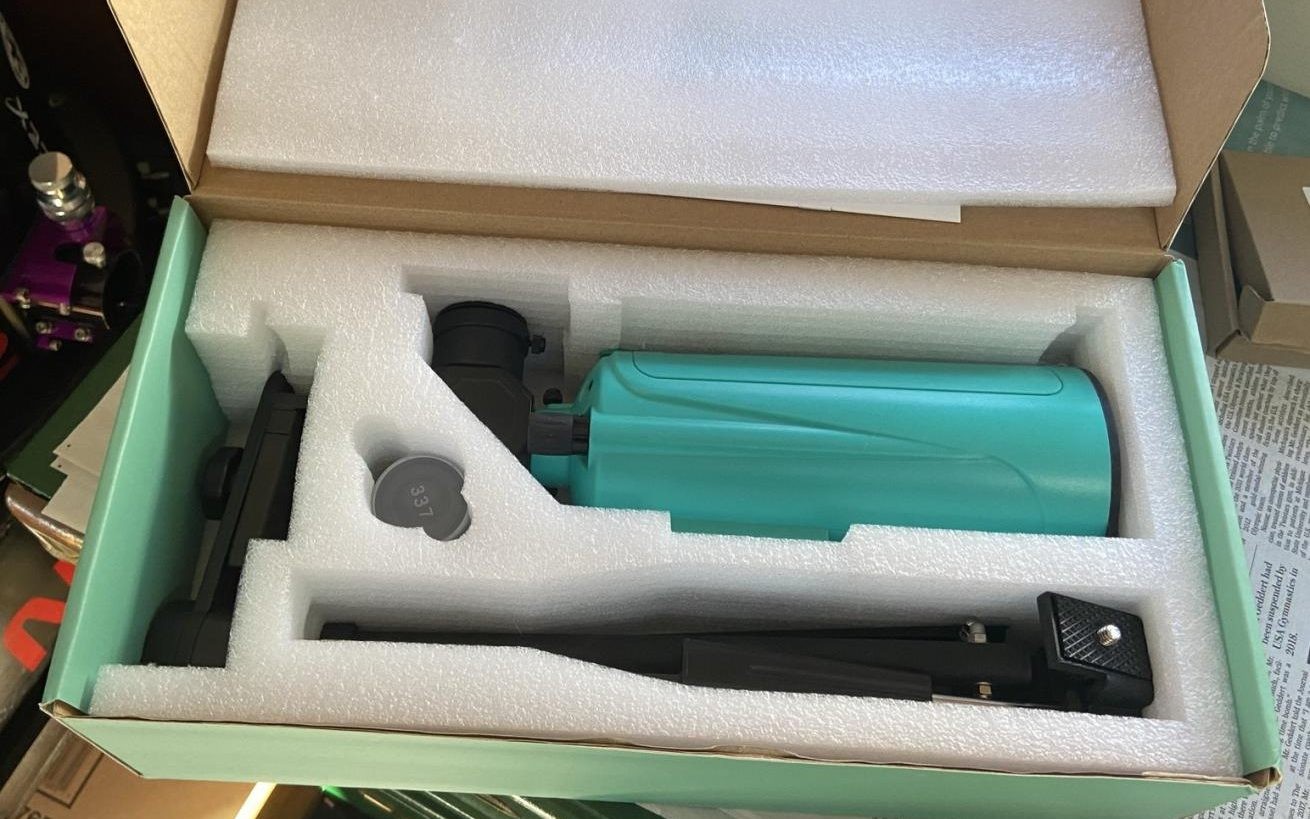The Excellent Mak60 Optical Tube
The optics of the Mak60 are excellent, as evidenced by a perfect star test that I conducted, which rivaled even premium telescopes costing thousands of dollars.
The SarBlue Mak60 is a 60mm aperture Maksutov-Cassegrain telescope with a focal ratio of f/12.5 and focal length of 800mm. While 800mm is not a particularly long focal length for a telescope, it results in magnifications that produce small exit pupils (making images dimmer) and a limited field of view when used with a small telescope like the Mak60.
The field of view of the Mak60 is further constrained by the small baffle of the optical tube and the 0.965″ diameter fitting of its rear accessory adapter instead of the standard 1.25″ size. However, the included star diagonal (a mirror bending light for us to view it more comfortably) that goes into this 0.965″ adapter can accept 1.25″ eyepieces. But if I use any of my wide-angle 1.25″ eyepieces here, this entire set up of Mak60 causes vignetting of the images. This limits my achievable field of view to under 1.5 degrees, or about triple the angular diameter of the Moon in the sky.
The Mak60 is made out of polycarbonate plastic, essentially the same stuff as a disposable water bottle, and is about the same size at only 8” (200mm) long and a bit under 3” (76mm) wide.
As with most Maksutov-Cassegrain and other catadioptric telescopes, the Mak60 features a number of interior baffles and an internal, moving-mirror focuser. I can view the optics and baffles within the Mak60 by removing the side panel of the telescope tube, which is a fun and educational bonus, as shown in the picture below. But I’ve noticed that it also invites dust and debris inside whenever I pop it off.

Focusing the Mak60 is achieved by turning a knob at the back of the telescope, which moves the primary mirror up and down the tube to adjust the position of the focal plane while the hardware attached to the rear of the telescope remains fixed.
To attach to its supplied tripod, the Mak60’s tube has ¼ 20 threaded inserts attached to the bottom.
The Decent Set of Accessories
The SarBlue Mak60 includes a prism star diagonal, a single 1.25” 20mm eyepiece (40x), and a 5×24 finder scope.
The 20mm eyepiece is made of polycarbonate plastic, just like the telescope’s optical tube and prism star diagonal. It’s optics are thankfully glass. The eyepiece is labeled as a Kellner but I’m confident that it’s actually a different optical design with three lens elements. It has an apparent field of view of about 50 degrees and is fairly sharp. However, 40x magnification does not provide the widest possible field of view with the Mak60, nor is it really sufficient for detailed planetary viewing, so additional 1.25” oculars are necessary.
The Mak60’s unusual prism star diagonal is also made of plastic and converts the telescope’s 0.965″ rear port to a regular 1.25″ eyepiece holder diameter. It is an Amici prism, which corrects left-right images so that we can easily use the scope for terrestrial viewing. The Amici prism diagonal is overall good and does not limit the Mak60’s optical performance if I ignore the glare and diffraction spike produced by the Amici prism design on bright targets.
The tripod-mounted Mak60 package includes a 5×24 finder scope with plastic optics and a plastic body. It is not very sharp optically and doesn’t reveal faint stars or otherwise provide advantages over a red dot unit, but it works well enough for aiming the scope.
An extremely basic smartphone adapter is provided with the Mak60 and can fit onto the supplied 1.25” eyepiece and many others. However, it runs the risk of causing the telescope to move away from what I’m pointing at or even tip over the tripod from the weight of my smartphone. The only purpose of a smartphone adapter is really for Moon photos anyway.
The Low-Quality Tripod
The tripod-mounted Mak60 comes with a generic, mostly plastic photo tripod that has the usual pan-tilt head, ¼ 20 mounting screw, extendable legs, center column, and locks of any other cheap photo tripod.
The Mak60 is so light that the typical balance issues that occur when the scope is aimed high in the sky were not as much of an issue for me as they are with heavier optical tubes.
However, the usual issues with such a tripod for astronomical use remain. The total lack of fine movement adjustments combined with the shakiness of such a lightweight tripod made aiming the Mak60 at even 40x with the stock eyepiece a bit annoying for me, as is making the frequent adjustments needed to keep a target in the field of view as the Earth rotates. Using higher magnifications worsens these issue.
Should I buy a Used SarBlue Mak60 w/Tripod?
If you can get one at a low price without damage to any of its plastic parts or corrosion to the optics, a used Mak60 should be fine. The tripod is probably the most fragile part of the setup, however.
Alternative Recommendations
The tripod-mounted SarBlue Mak60 is not one of my preferred picks in its price range; I’d recommend the tabletop Dobsonian mounted edition instead or going with a larger aperture Dobsonian telescope.
Under $200
- The tabletop Dobsonian mounted SarBlue Mak60 offers the same optics and accessories but without the stability and fine adjustment issues of the tripod; you can easily attach the optical tube to your own high-quality photo tripod if you wish anyways.
- The Zhumell Z100 offer significantly more light-gathering ability and resolving power than the tiny Mak60, as well as a much wider achievable field of view more suitable for viewing deep-sky objects. These telescopes do require a dedicated planetary eyepiece (not included) for high-power views, however, which can be harder to find and more expensive than a simpler ocular for the Mak60.
$200-$300
- The Sky-Watcher Heritage 130P offers more than quadruple the light-gathering ability and twice the resolving power of the Mak60. Its collapsible tube and tabletop Dobsonian mount make it extremely compact and easy to transport, and the included accessories are decent too. A 150mm version, the Heritage 150P, is also available, as are GoTo versions of both telescopes under the Sky-Watcher Virtuoso GTi line.
- The Zhumell Z114 have slightly more aperture than the 100mm tabletop Dobsonian models and are slightly sharper optically, as well as a little easier to be collimated by the user. These telescopes significantly outperform the Mak60 for both deep-sky and planetary viewing.
Aftermarket Accessory Recommendations
If you are considering purchasing accessories for the SarBlue Mak60, it may be better to save your budget for a larger telescope instead.
However, the addition of a higher-magnification planetary eyepiece in the 11–6.5mm focal length range (72–125x) will significantly improve your views of the Moon, planets, and double stars. The 9mm generic redline/goldline eyepiece (89x) is my top pick for such an eyepiece and is fairly sharp as well as affordable.
What can you see?
The Mak60’s small aperture, which limits its light-gathering power, combined with its narrow field of view, make it more suited for viewing the Moon and planets than deep-sky objects.
- It is capable of showing me the phases of Venus and Mercury (the latter requiring more than 40x magnification to resolve) and offers clear views of lunar features such as craters, mountains, and ridges as small as a few miles across.
- With a high-power eyepiece, I’m able to see some dark markings on Mars, along with its polar ice caps, when the planet is close to Earth.
- Jupiter’s four large moons, cloud belts, and the Great Red Spot are also visible through the Mak60. When the four Galilean moons of Jupiter transit, the Mak60 can resolve the disks and shadows of larger Ganymede and Callisto under good conditions, though Europa and Io are typically beyond its reach.
- I can also see the Cassini Division in Saturn’s rings, a few of Saturn’s moons, and the planet’s cloud belts.
- Uranus and Neptune are indiscernible from the stars, and their moons are too faint to see with only 60mm of aperture.
- Pluto requires a telescope with an aperture 3–4 times that of the Mak60 to be visible even under the best conditions.
I find most deep-sky objects fairly unremarkable in a 60mm telescope like Mak60, even under dark skies, and those that are—the largest nebulae and star clusters—are too big to look good at the boxed-in field of view and high magnifications the Mak60 is stuck with.
Galaxies, globular clusters, and planetary nebulae are invisible or faint smears at best. The Orion Nebula and Lagoon Nebula show their brightest gaseous regions, along with star clusters within. A few of the smaller but bright open star clusters are still nice to look at thanks to the pinpoint stars the Mak60 delivers, but a large scope shows fainter stars and reveals more vivid colors as well as delivering far more capability in viewing other deep-sky objects.




Greetings! I find this mini-Mak is a remarkable telescope for about the size of a 6″ Subway sandwich! I agree the optics are essentially perfect – I like to think of this guy as the world’s smallest Japanese 60/800 refractor! As a longtime astronomer, I have lots of eyepieces which work very well with this mini-Mak – I usually carry 25mm/ 17mm Plossls with a short Barlow for about as much flexibility this guy will handle. The teal color is super cool, and I’m an astronomy instructor, and use this guy as my teaching example of a Mak – you can open the side and show the innards! I just dazzled a small group with tabletop views of Saturn last weekend – they were very impressed.
Finally I have several tabletop Dobsonian stands, and this mini-Mak easily fits any of those for a super stable and smooth tabletop experience. I got mine new for $60, and it feels like the Deal of the Century for a telescope plus accessories that can fit into my neoprene laptop bag!